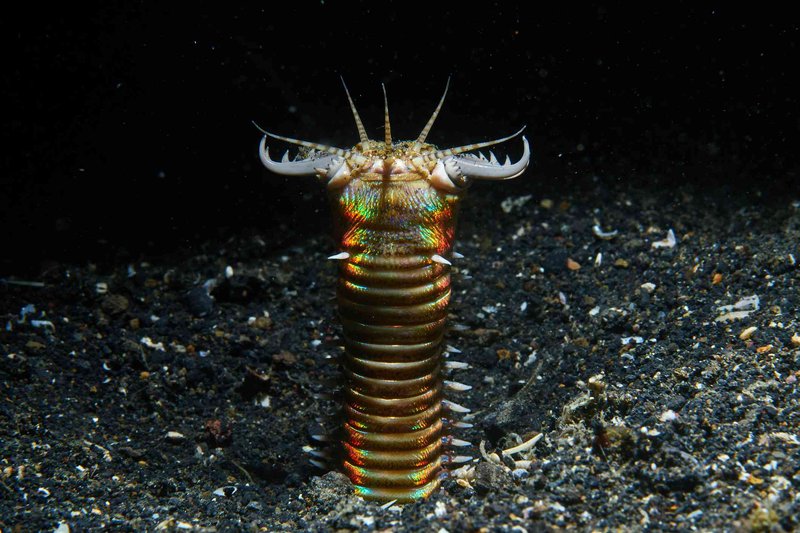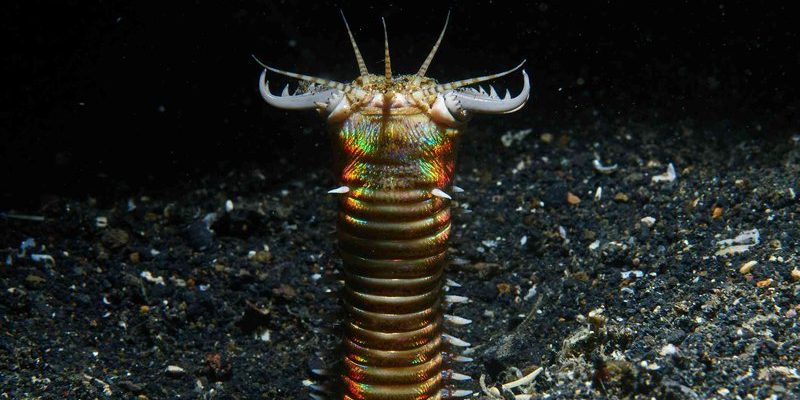
Picture this: you’re sitting on a beach, watching the waves roll in. Underneath the sand, hidden from sight, lies a creature that can quickly strike out and capture prey with astonishing precision. That’s the Bobbit worm for you—an incredible adaptation of nature that has evolved over millions of years. Understanding its bite force and jaw composition gives us a glimpse into its survival strategies and role in the ecosystem. So, let’s dive into this marine mystery!
What is the Bobbit Worm?
The Bobbit worm, or *Eunice aphroditois*, can be found in tropical and subtropical waters around the world. Think of it as a fierce underwater predator, often reaching lengths of up to 10 feet, though they can be even longer! Not only does it boast a striking appearance with its colorful body, but it has some unique hunting tactics.
These worms live in burrows, camouflaged beneath the ocean floor, waiting patiently for unsuspecting prey to swim by. When a fish or another critter gets too close, the Bobbit worm snaps into action—it lunges out with remarkable speed and agility, showcasing both its swift reflexes and powerful bite.
Unlike many marine creatures, Bobbit worms are segmented, which helps them move efficiently through their sandy homes. This segmentation also plays a crucial role in their ability to capture prey. Each segment is equipped to help with movement and hunting, making it a truly fascinating organism.
The Anatomy of a Bobbit Worm’s Mouth
Now that we know what the Bobbit worm is, let’s take a closer look at its remarkable mouth structure. The jaw of a Bobbit worm is not your typical jaw. It features sharp, pointed jaws that can slice through flesh with incredible ease. Think about how a pair of scissors works—they snap quickly and cleanly. The Bobbit worm’s jaws operate in a similar fashion, allowing it to grab and slice its prey efficiently.
These jaws are made from a material called chitin, which is tough yet flexible. This makes them strong enough to exert force during a bite while still being light enough not to hinder movement. Chitin is also found in the exoskeletons of insects and crustaceans, emphasizing the evolutionary traits that the Bobbit worm shares with other organisms.
Moreover, the upper part of the jaw has some adaptations that help with gripping slippery prey. The presence of tiny, hook-like structures allows the worm to hold onto its catch long enough to pull it into its burrow. This unique jaw composition not only aids in hunting but also showcases how specialized this marine creature truly is.
Understanding Bite Force in Bobbit Worms
When it comes to bite force, Bobbit worms have made quite an impression in the animal kingdom. Studies exploring their bite force reveal that they can exert a surprising amount of pressure. This force is essential for subduing prey, which often includes fish and crustaceans. Imagine the intensity of their bite as akin to that of a small dog—definitely enough to get your attention!
To put it in perspective, researchers have measured the bite force of various marine predators, and the Bobbit worm ranks among the stronger contenders. While different species vary, some studies suggest that they can exert a force of around 60-140 Newtons. That’s quite impressive for a creature that might not seem intimidating at first glance!
This bite force gives the Bobbit worm the upper hand when hunting. It allows them to capture prey quickly and effectively, which is a vital part of their survival strategy in the competitive ocean ecosystem. The fact that they can immobilize their catch so rapidly ensures they get the nutrients they need to thrive.
Why Study Bite Force and Jaw Composition?
You might be wondering, “Why go to all this trouble studying Bobbit worms?” The bite force and jaw composition of these creatures give scientists valuable insight into their predatory behaviors, evolutionary adaptations, and the ecological balance of their habitats.
Understanding these aspects can also help researchers learn about other marine life. For instance, examining the Bobbit worm’s unique adaptations may lead to discoveries about how similar traits evolve in different species. This knowledge is essential for conservation efforts as well, especially as marine ecosystems face threats from climate change and human activity.
Additionally, studying these jaw mechanics can lead to breakthroughs in materials science. The chitin that makes up the Bobbit worm’s jaws is being researched for its potential applications in various fields, from biodegradable plastics to medical implants. It’s fascinating how a creature living in the depths of the ocean can inspire innovations on land.
Comparing Bobbit Worms to Other Marine Predators
The Bobbit worm isn’t the only predator in the deep blue sea. Comparing it to other marine creatures reveals some interesting differences in hunting styles and adaptations. For example, consider the anglerfish. Armed with a bioluminescent lure, the anglerfish attracts its prey before launching a fierce strike. While both the Bobbit worm and anglerfish are effective hunters, they rely on different strategies.
Another notable predator is the lionfish, which uses venomous spines to deter attackers while ambushing prey. The lionfish and Bobbit worm share a fierce reputation, but their methods diverge significantly. The Bobbit worm’s stealth and speed contrast with the ambush tactics of the lionfish, highlighting the diversity in predation methods across species.
When you look at them side by side, it’s like watching a nature documentary with two different episodes playing at once—each showcasing the unique adaptations that allow these creatures to thrive in their underwater environments.
Implications for Marine Ecology and Conservation
Studying the Bobbit worm’s bite force and jaw composition goes beyond just animal behavior; it has critical implications for marine ecology and conservation. Understanding how top predators like the Bobbit worm fit into the food web helps us grasp the delicate balance of marine ecosystems.
For instance, a decline in Bobbit worm populations could disrupt local food chains, affecting everything from the organisms they prey on to the species that rely on those prey for survival. Monitoring these and other predator populations provides insights into the overall health of marine environments.
Furthermore, as human activity continues to impact oceans through pollution, overfishing, and habitat destruction, studying organisms like the Bobbit worm can help shape conservation strategies. We need to ensure these fascinating creatures remain a part of our underwater world, contributing to the biodiversity that keeps our oceans thriving.
In essence, the bite force and jaw composition studies of the Bobbit worm aren’t just about understanding one creature—it’s about preserving the intricate tapestry of life in our oceans.
In conclusion, the Bobbit worm is more than just a marine curiosity. Its formidable bite force and unique jaw composition tell a story of adaptation and survival in the vast ocean. By studying this fascinating predator, we not only learn about its biology but also gain insights into the health of our marine ecosystems. So, next time you think of the Bobbit worm, remember that it’s not just a worm; it’s a vital player in the underwater narrative, shaped by nature’s own hand.

